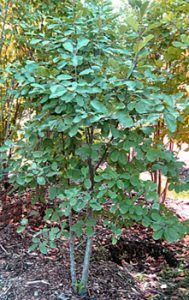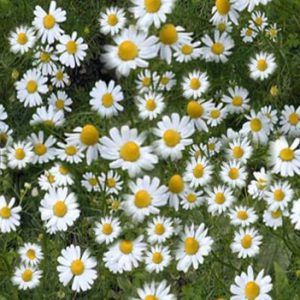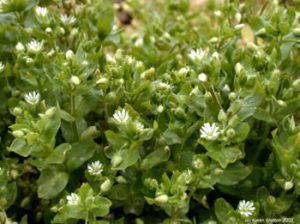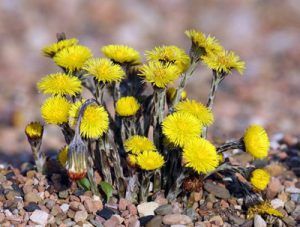Herbs A B C D E F G H I J K L M N O P Q R S T U V W X Y Z
C
Calamus Root – See Sweetflag
Cardinal Flower – Formally called Lobelia Cardinalis, this plant with bright red flowers is native to the Americas, from southeastern Canada south through the eastern and southwestern United States, Mexico, and Central America. Native Americans used the root to heal intestinal ailments, worms, epilepsy, typhoid, cramps, and syphilis. Leaf tea was used for colds, bronchial problems, croup, nosebleed, fever,headache, and rheumatism. A poultice of the roots has been used on hard to heal sores and applied to the head to relieve the pain of a headache. The Penobscot tribe smoked the dried leaves as a substitute for tobacco. As a member of the Lobelia family, it is considered to be potentially toxic, but the degree of toxicity is unknown. The sap of the plant has been known to cause skin irritation.
Cascara Sagrada – Officially called Rhamnus Purshiana, it comes from a species of Buckthorn tree native to western North America from southern British Columbia south to central California and inland to western Montana. Also known as Cascara Buckthorn, Chitticum Bark, Sacred Bark, and Bearberry, dried and aged bark is used primarily for bowel problems. It has a powerful laxative effect and is believed to improve the muscle tone of the colon walls. The dried bark can be made into tea, although it tastes bitter. Fresh cascara bark should not be used because it can cause bloody diarrhea and vomiting. It should be aged for at least one year or put through a special heat treatment.
Catnip/Catmint – Officially called Nepeta Cataria, it is also known as catswort. Although native to Europe, Asia, and Africa, it is now also common in North America. The herb has a long history of medicinal use for its soothing properties and has also been known to have a slightly numbing effect. Consumed in teas, used in poultices, and smoked. Stems and leaves used fresh or dried, are used to make an aromatic herb tea, which has been found to be effective in treating disorders of the digestive system, reducing fever, treating colds, flu, and infant colic. It has also been found to be useful in the treatment of restlessness and nervousness. Externally, salves are made from the leaves and applied to bruises, especially black eyes. Raw young leaves, which have a mint-like flavor, have often been used as a seasoning in salads and cooked foods. When isolating the oil of the plant, it has been found to deter insects, mice, and rats.
Cattail – Officially called Typha, there are about 11 species mostly found in wetland habitats of the Northern Hemisphere. It is also commonly known by several names, including Bullrush, Reedmace, Punks, and Corndog Grass. These were often used to make a nutritious and energy-rich food source that was processed into flour. Pollen was also collected from mature male flowers and used as a flour supplement or thickener. In Native American herbal medicine, various species were used in poultices applied to burns, wound infection, sprains, boils, and swelling. Internally, it was used for abdominal cramps, kidney stones, whooping cough, cysts, gonorrhea, and diarrhea. Specifically, the Apache used the pollen in a number of remedies; the Dakota, Ponca, and Pawnee used it for dressing burns and scalds; the Algonquin to treat infection, the Cahuilla for bleeding wounds. The Cheyenne were also known to have used leaves in their Sun Dance ceremony.
Cat’s Claw – Officially known as Uncaria Tomentosa, it is also sometimes called Cat’s Nail. A tropical vine that grows in the rainforest and jungles of South America and Asia, it has been used for medicinal purposes for more than two thousand years as a general health tonic, contraceptive, anti-inflammatory agent, gastrointestinal and urinary tract problems, diarrhea, rheumatic disorders, respiratory problems, acne, and, diabetes. Current studies also show it may have positive effects on and can boost the body’s immune system, treatment in Aids, diabetes, PMS, chronic fatigue syndrome, prostate conditions, and cancer.
Cayenne – Formally known as Capsicum, it is also commonly known as Chili Pepper, Hot Pepper, Red Pepper, Tabasco Pepper, Pimiento, Mexican Chili, and many other local names. It is native to the Americas, where they have been cultivated for thousands of years by people in the tropical regions, and is now cultivated worldwide. Used as both a food and for medicinal purposes, it was best known for the treatment of circulatory and digestive problems. Other conditions it was used for were rheumatism, arthritis, chronic nerve pain, shingles, diabetes, stomach ailments, heart disease, varicose veins, headache, menstrual cramps, and asthma. It was also used as a gargle for throat irritation. Externally, it was applied to wounds to increase blood flow and numb the pain. More recently, it has been used for lower blood pressure and cholesterol.
Cedar – Officially called Cedrus, these large evergreens with needle-like leaves, generally grow at high altitudes in both full sun and wet, misty forests. Of the Pine Tree Family, its wood, berries, leaves, and oil are all used for medicinal purposes. Growing around the world, the tree has been used for various purposes since ancient times, including as incense, perfumes, embalming, and in medicines such as disinfectants, antiseptics, astringents, and sedatives. In teas, it was used for respiratory conditions, joint pain, water retention, flatulence, fungal infections, to improve appetite and digestion, coughs, colds, fever, and flu. In salves and oils, it was used for wounds, skin rashes, hair loss, eczema, acne, warts, fungal, infections, hemorrhoids, sore joints, syphilis, leprosy, and on the chest for asthma. Cedar leaves are used to treat tuberculosis and a decoction of wood is given for chest infections, insomnia, and diabetes.
Native Americans utilized every part of the cedar tree. They made spears and arrows from the wood, burned the wood for fuel and incense, used the leaves and branches as insecticides, made medicines, offered it to the sacred fire during sweat lodge ceremonies, and burned it during prayers. It was also used for various medicinal purposes. When boiled, it is used to purify indoor air and cedar baths.
Chamomile – A common name for several daisy-like plants, they are best known for their ability to be made into a tea which is commonly used to help with sleep. They are also known to be used for gynecologic complaints, including PMS and cramps, treating stomach and intestinal cramps and problems, nausea, and stomach flu. It is also an excellent calming agent and well suited for babies and children.
Chasteberry – Officially known as Vitex Agnus-catus, this is the fruit of the Chaste tree and has been used for thousands of years to help reduce the symptoms of menstrual problems and to stimulate the production of breast milk. Also known as chaste tree berry, vitex, and monk’s pepper, it was reportedly used by monks in the middle ages to decrease sexual desire and preserve chastity, hence the name. However, it is now clear that the herb does not affect sex drive. The berries and flowers were used in teas for PMS, to ease menopausal symptoms, for breast pain, acne, fertility. Today, it has also been found to be effective as an anti-inflammatory, bone strength, and epilepsy. Pregnant or breastfeeding women should not take chasteberry.
Chokecherry – Officially known as Prunus Virginiana, it is also called Western Chokecherry, Black Chokecherry, and Wild Cherry. Varieties can be found all over the United States and Canada. Numerous tribes, including the Mohawk, Huron, Miami, Delaware, Cree, Ojibwe, Penobscot, Iroquois, Chippewa, and others, have long used the tree as a source of food and medicine. In early American medicine, it was considered one of the most important native drugs, ranked along with Sassafras. The berries were collected and dried for later consumption, and the bark of the tree was used in the treatment of smallpox, scurvy, soreness of the chest and throat, lung hemorrhages, cough, colds, inflammation of the bowel, diarrhea, stomach cramps, cholera, digestive problems, gangrenous wounds, sores, pains, severe burns, and wounds. When Europeans arrived in America, they learned from the Indians about the health properties of chokeberry and began to use it to treat cough, colds, consumption, and malaria, burns, and wounds. There are minor differences between the varieties, including the color of the fruit ranging from red to purple to black. Though the berries are obviously edible, caution should be used because the pit can be poisonous if consumed in large enough quantities.
Chlorella – A genus of single-celled green algae that has shown promise as having anti-tumor properties and effectiveness in cancer prevention, immune system support, weight control, reducing high blood pressure, lowering cholesterol levels, and accelerating wound healing.
Chickweed – Officially known as Stellaria Media and Stellaria Pubera, its probable origin is Eurasia but is now established all over the world. In North America, it is widespread from the Brooks Range in Alaska to all points south. Also known as Common Chickweeds, Star Chickweed, and Mouse-ear Chickweed, they have been used for both food and medicine. High in vitamins and minerals, the whole plant has been used as an astringent, antihistamine, diuretic, and expectorant, as well as treating constipation, cough, cystitis, and kidney and urinary tract complaints. Externally, poultices have been used to treat rheumatic pains, wounds, ulcers, roseola, itching skin conditions, cuts, minor burns, eczema, and rashes.
Cinnamon Bark – Obtained from the inner bark of several trees from the genus Cinnamomum that is native to southeast Asia, the use of cinnamon dates back over 4,000 years and is also mentioned in the Bible. It has a broad range of historical health applications in different cultures, and over those years, has been used to boost cognitive function and memory, treat rheumatism, colds, diarrhea, diabetes, toothache, help with digestion, and to relieve certain menstrual disorders. Regularly drinking tea made from the bark of Sri Lanka cinnamon is thought to be beneficial to oxidative stress-related illnesses as it contains significant antioxidant potential.
Cloves – Known officially as Syzygium Aromaticum, these aromatic dried flower buds are native to Indonesia and used as a spice and in medicinal remedies. Some uses include toothache, bad breath, cough, skin infection, gum problems, indigestion, flatulence, nausea, and heartburn. It also has anti-oxidant properties.
Club Moss – Officially called Lycopodiopsida, this herb has several other names, including Clubfoot Moss, Foxtail, Ground Pine, Running Club Moss, Staghorn, Vegetable Sulfur, and Wolf’s Claw. Medicinal use of the club moss started quite early in Europe and may have begun as early as the Middle Ages for many herbal remedies. The old name of Vegetable Sulfur refers to the highly flammable oil contained in the powder. It has been used to treat kidney stones, urinary tract infections as a diuretic.
Coltsfoot – Scientifically known as Tussilago Farfara, this dandelion-looking plant has been used medicinally throughout the world for thousands of years. Pedanius Dioscorides, a Greek physician, and pharmacologist, who lived from 40-90 AD, recommended it for cough and asthma. Known by several other names, including British Tobacco, Bullsfoot, Butterbur, Coughwort, Flower Velure, Horsehoof, and others, it was native to several locations in Europe and Asia. It was introduced to the Americas by early colonists and now grows in North America, from Kentucky and Tennessee northward to Ontario and Quebec in Canada, as well as west of the Mississippi River in Minnesota and Washington. Its leaves were usually smoked for cough, bronchitis, whooping cough, and other respiratory disorders. Crushed leaves were also used in teas and tonics for flu, pleurisy, sore throat, inflammation, fever, diarrhea, and indigestion. Crushed leaves and flowers were also used externally for various skin disorders, insect bites, inflammation, burns, skin ulcers, and sores. Today, it has been found that coltsfoot contains an alkaloid that promotes tumor growth and has resulted in liver health concerns. For this reason, its use as medicine may not be advisable.
Coneflower – See Echinacea
Cotton – Of the genus Gossypium, cotton is native to tropical and subtropical regions around the world, including the Americas, Africa, and India. Roots, leaves, and seeds have been used in the treatment of urinary problems to aid the contraction of the uterus after childbirth, excessive bleeding during menstruation, for healing wounds and burns, dysentery, and diarrhea. The Alabama and Koasati tribes made a tea of the roots of the plant to relieve the pains of labor.
colds.
Creosote Bush – Officially, the plant is called Larrea Tridentata, and many refer to it as “chaparral” as a medicinal herb. It is prominent in the deserts of the south and the western U.S. A tea of the leaves was made by Native Americans of the Southwest and used as a treatment for respiratory problems, sexually transmitted diseases, tuberculosis, chickenpox, dysmenorrhea, and snakebite. Unfortunately, the U.S. Food and Drug Administration has issued warnings about the health hazards of ingesting chaparral today as it is said there is a risk of liver and kidney damage.
D
Damiana – Officially known as Turnera Diffusa, the small aromatic shrub is native to southwestern Texas, southern California, Central America, Mexico, South America, and the Caribbean. It has long been claimed to have a stimulating effect on libido, and its use as an aphrodisiac has continued into modern times. It has also been used to increase energy, improve digestion, and in the treatment of asthma, depression, impotence, menstrual problems, anxiety, nervousness, and constipation.
Dandelion – Officially called Taraxacum Officinale, it is known by most people as a common weed; but to herbalists for its many culinary and medicinal uses. Rich in vitamins A, B complex, C, and D, as well as minerals such as iron, potassium, and zinc, its leaves have often been used to flavor food and teas, its roots in coffee substitutes, and the flowers, to make certain wines. In traditional medicine, dandelion roots and leaves were used to treat liver problems, kidney disease, swelling, skin problems, heartburn, and stomach upset. A tea of the roots was drunk for heartburn by the Pillager Ojibwas, and the Mohegan tribe drank a tea of the leaves as a general health tonic. The Chinese used it to treat digestive disorders, appendicitis, and breast problems (such as inflammation or lack of milk flow). In Europe, herbalists incorporated it into remedies for fever, boils, eye problems, diabetes, and diarrhea. Today, dandelion roots are mainly used as an appetite stimulant, a diuretic, digestive aid, and for liver and gallbladder functions.
Devil’s Claw – Formally called Harpagophytum Procumbens, this plant, native to southern Africa, is also called Grapple Plant, Harpagon, Wood Spider, and Devil’s Club. Used for thousands of years by indigenous people of that country, it was used to treat fever, rheumatoid arthritis, skin conditions, and conditions involving the gallbladder, pancreas, stomach, and kidneys, as well as a numbing agent. Later it was brought to Europe and utilized primarily to improve digestion and treat arthritis. After it was brought to the Americas, the Indians of British Columbia utilized a tea of the root bark to offset the effects of diabetes. The roots and tubers are still used today to reduce swelling, joint disease, arthritis, gout, back pain, headache, constipation, diarrhea, sores, skin conditions, and as an appetite stimulant. Devil’s claw should not be used by women who are or may be pregnant, as it is believed to cause uterine contractions.
Dogbane – See Indian Hemp

Cherokee Herbal Remedies from Nuwati Herbals. Made in Missouri and available at Legends’ General Store
Dogwood – Scientifically known as Cornus Florida, this flowering tree native to the U.S. can be found from Maine to Florida and west to Minnesota, Kansas, and Texas. Having several other common names, including American Dogwood, Boxwood, Budwood, Cornelian Tree, Flowering Dogwood, Green Ozier, and others, its inner bark, berries, and twigs have long been used in Native American remedies. Primarily it was used internally to treat malaria, fever, pneumonia, colds, and diarrhea, as well as improving digestion and appetite. Externally, poultices were used to heal ulcers and sores. In the early 19th Century, a report was made that Native Americans in Virginia were remarkable for their white teeth. They utilized twigs as chewing sticks, which acted as a toothpick and chewing brush. The Iroquois were known to use the twigs in a tonic for gonorrhea, and the Cherokee chewed the bark for headache and used a decoction of bark to treat childhood afflictions such as worms, measles, and diarrhea. They also made poultices, which were also used for wounds, and other skin disorders. The Menominee used the bark in enemas, and the Arikara mixed it the bearberry to make sacred tobacco. It was widely used in the South during the Civil War for malarial fever and chronic diarrhea.
Dong Quai – Officially called Angelica Sinensis, and also known as Chinese Angelica, Dang Gui, the Female Ginseng, and Tang Kuei, the root has been used for more than a thousand years as a spice, tonic, and medicine in China, Korea, and Japan. In traditional medicine, it was usually combined with other herbs to treat women’s reproductive problems, including PMS and cramps, improve circulation, and ease menopausal symptoms. It has also been found to be effective in treating weakness after childbirth, chronic nasal or sinus congestion, fibroid tumors, high blood pressure, fibrocystic breast disease, rheumatoid arthritis, anemia, allergies, constipation, shingles, hepatitis, and headache. Studies today suggest that it may also reduce pain, dilate blood vessels, and stimulate and relax uterine muscles.
Disclaimer: These statements have not been evaluated by the Food and Drug Administration, and we make no medical claims nor intend to diagnose, treat, or heal medical conditions. Women who are pregnant or nursing or persons with known medical conditions should consult their physician before taking any herbal products.




